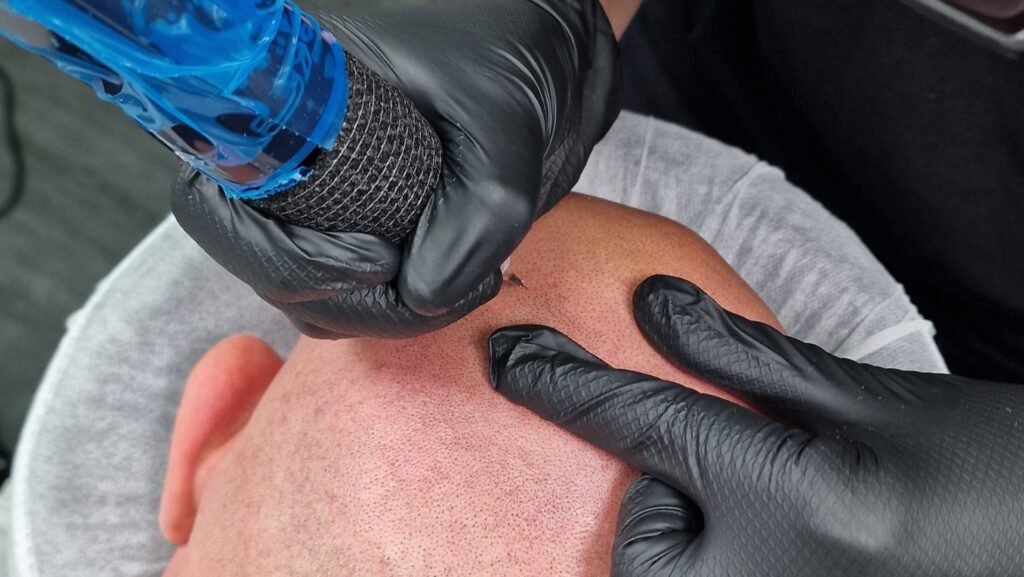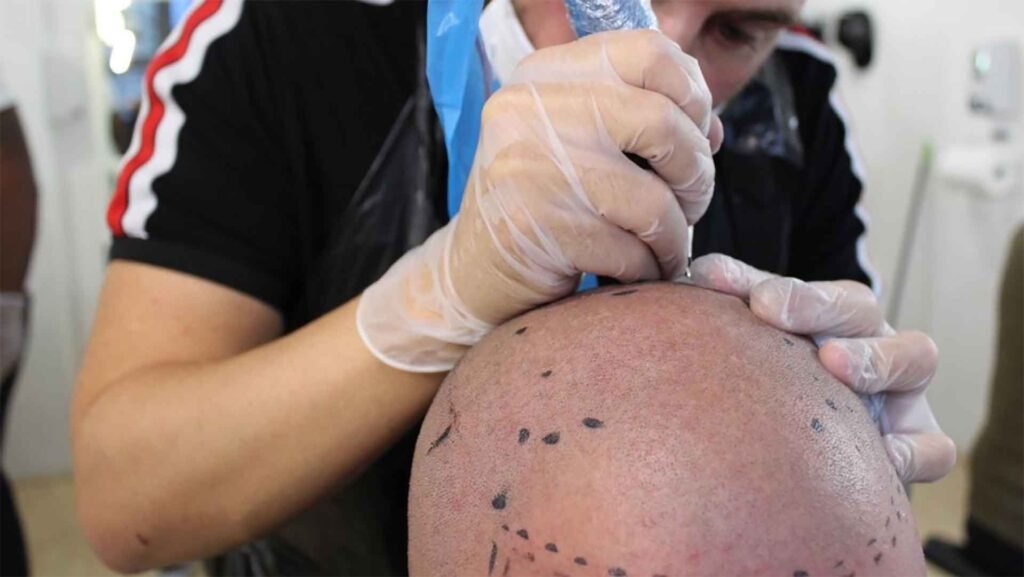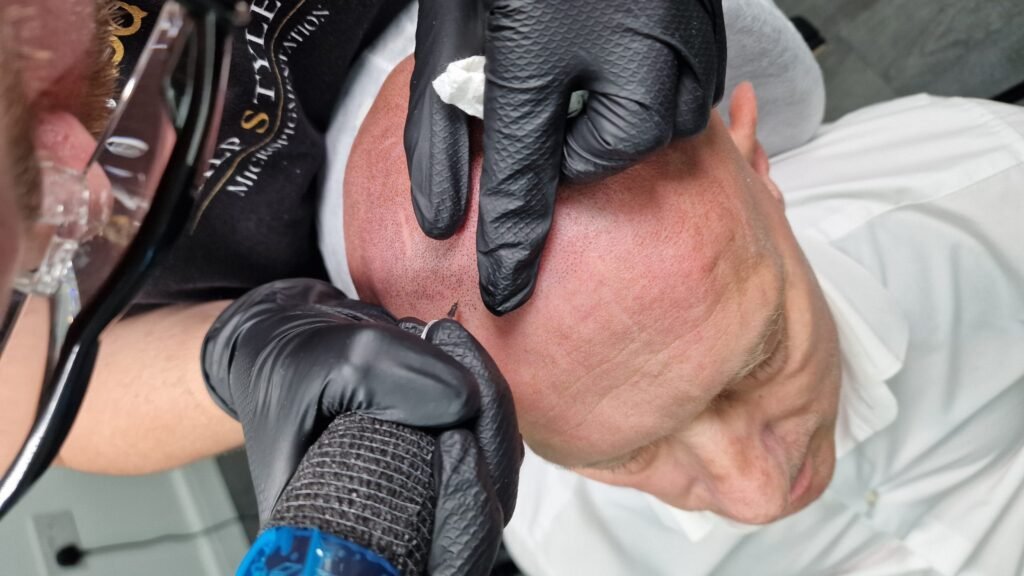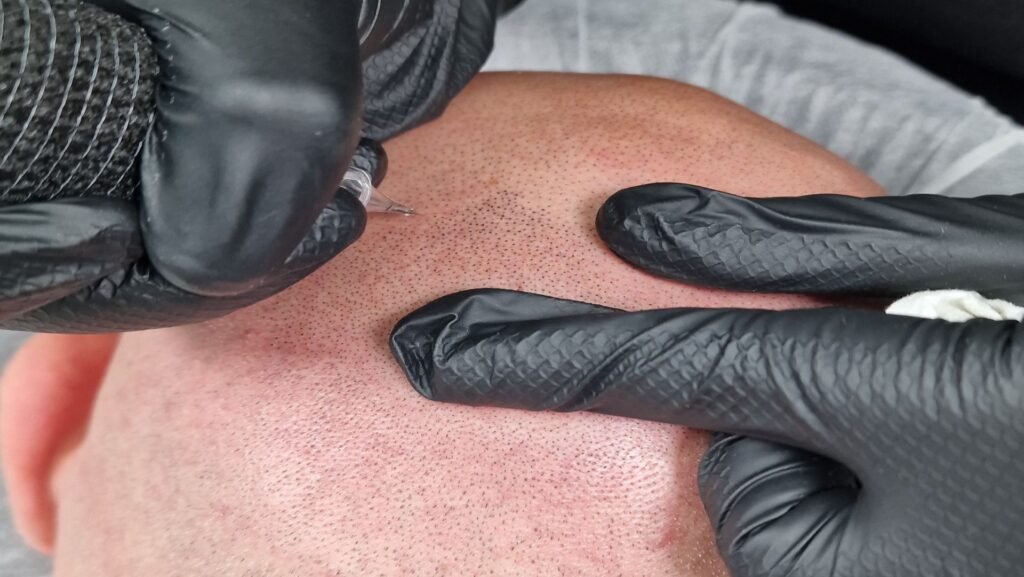Have you ever wondered, ‘how long does scalp micropigmentation last?’
This post explores the longevity of SMP.
Whether you’re just dipping your toes into the world of hair loss solutions or on the verge of choosing SMP, understanding how long it lasts is crucial. In this post, we will unravel the mystery behind the longevity of scalp micropigmentation.
We’ve got you covered, from what influences its duration to how you can make the most out of your treatment. So, pop the kettle on, make yourself a cuppa, and dive into the world of SMP, a brilliant solution that’s more than just skin deep.
In the bustling beauty and wellness industry, SMP has made quite a mark as a savvy solution for hair loss. Whether filling in a receding hairline or adding density to thinning areas, SMP could be the ticket to regaining your confidence. But how long does this impressive effect last? Let’s find out together as we explore the typical lifespan of SMP and how you can extend it with the proper care.
Stay tuned as we delve into the nitty-gritty of scalp micropigmentation and ensure you’re well-informed to make the best decision for your hair needs.

Understanding Scalp Micropigmentation
Scalp Micropigmentation (SMP) is not just another hair loss treatment—it’s a crafty cosmetic wizardry. At its core, SMP involves the application of specialised pigments to the scalp using micro-fine needles. It’s akin to getting a tattoo, but it’s much more subtle and specifically designed to mimic the appearance of tiny hair follicles. Here’s a breakdown of what SMP is all about, how it’s performed, and why many are turning to it as their preferred hair loss solution:
How It’s Done:
- Application Technique: A trained practitioner uses micro-needles to deposit pigment into the scalp. The technique requires precision and artistry to ensure the dots look natural and blend seamlessly with your existing hair pattern.
- Pigment Selection: The pigment’s colour is carefully matched to your natural or desired hair colour to create a consistent and realistic look.
- Sessions Required: Typically, the process requires 2-3 sessions, each lasting a few hours, spread over several weeks to allow for healing.
Typical Uses of SMP:
- Thinning Hair: SMP adds density to areas where hair is thinning, making your hair appear fuller.
- Receding Hairlines: It can redefine hairlines, providing a younger, more confident look.
- Complete Baldness: For those who have lost all hair, SMP offers the look of a full buzz cut.
- Scars Concealment: It can also camouflage scars or other imperfections on the scalp.
Why Choose SMP Over Other Solutions?
- Non-Invasive: Unlike hair transplants, SMP doesn’t involve surgery, making it a safer and less invasive option.
- Low Maintenance: Once completed, SMP requires very little maintenance, allowing you to return to your daily routines without ongoing treatments.
- Cost-Effective: Generally, SMP is more affordable than hair transplants and doesn’t require the costly maintenance of medicinal treatments.
- Immediate Results: Results are visible from the first session, improving with each subsequent session.
- Longevity and Durability: While not permanent, SMP provides long-lasting results that can be touched every few years to maintain sharpness and style.
Many choose SMP because it provides a realistic appearance of hair without the hassle and downtime of more invasive procedures. It’s an artful solution that requires little maintenance, offering a dependable way to boost confidence and restore a youthful appearance. Whether you’re looking to add density to thinning areas or achieve a stylishly defined hairline, SMP might be the answer you’ve been searching for.
How long does Scalp Micropigmentation last?
One of the critical considerations when deciding on Scalp Micropigmentation is understanding how long you can expect the results to last. Here’s what you need to know about the longevity of SMP and how various factors can influence its duration:
General Lifespan:
- Typical Duration: On average, SMP can last 4 to 6 years before a touch-up might be needed. However, this timeframe can vary based on several factors, including your lifestyle and the care you give your scalp.
- Visibility and Fading: Over time, the pigments may fade gradually, leading to a softer appearance. This fading process is natural and expected, partly due to the body’s immune response and exposure to external elements.
Factors Influencing Longevity:
- Sun Exposure: Prolonged exposure to the sun can accelerate the fading of the pigments. Wearing a hat or using SPF protection can help maintain the pigment’s vibrancy.
- Skin Type: Oily skin can cause pigments to fade quicker than dry skin types. Regular cleansing can mitigate some of this effect.
- Aftercare: Following your SMP technician’s aftercare advice—such as avoiding chlorine and direct sunlight immediately after treatment—is crucial for ensuring the results last.
- Immune System: Individual variations in the immune system can affect how quickly the body metabolises the pigment.
Maintenance and Touch-Ups:
- Regular Touch-Ups: To maintain the crisp appearance of your SMP, touch-ups are recommended every few years. These sessions are typically quicker and less extensive than the initial application.
- Adapting to Changes: As you age, natural changes in your hair colour and skin tone might necessitate slight adjustments in the pigment colour used during touch-ups.
Understanding these factors can help you set realistic expectations and plan for the future maintenance of your SMP. With proper care and occasional touch-ups, your scalp micropigmentation can continue to provide a confidence-boosting appearance for years to come.

Factors That Affect the Longevity of SMP
Scalp Micropigmentation is a robust solution for hair loss, but like any cosmetic treatment, certain factors can influence how long the results will last. Understanding these can help you maximise the lifespan of your SMP treatment. Here’s what impacts the durability of SMP:
Exposure to Sunlight:
- Impact: Ultraviolet (UV) rays can cause the pigment to fade rapidly.
- Prevention: Regular use of a high SPF sunscreen on the scalp, wearing hats, and limiting direct sun exposure can significantly preserve the colour and sharpness of SMP.
Quality of Pigment Used:
- Impact: High-quality pigments last longer and resist fading better than inferior options.
- Selection: Always choose an SMP provider that uses top-tier, medical-grade pigments explicitly designed for micropigmentation.
Skill and Technique of the Practitioner:
- Impact: The depth at which pigment is implanted and the technique used can affect how the skin holds the pigment.
- Selection: Ensure that your SMP practitioner is highly skilled and experienced. Their technique should be refined through proper training and practice.
Personal Health and Lifestyle:
- Impact: Your body’s metabolism, immune response, and overall health can influence how long SMP lasts. Active lifestyles and frequent sweating might accelerate fading.
- Management: While you can’t always control your body’s reactions, maintaining good overall health can prolong the effects.
Aftercare Compliance:
- Impact: How well you follow aftercare instructions directly affects the healing process and the settling of the pigment.
- Prevention: Adhere strictly to the aftercare regimen provided by your SMP specialist. This typically includes keeping the treated area clean, dry, and protected from irritation and sun exposure immediately after the procedure.
Scalp Hygiene:
- Impact: Excessive oil production can lead to faster pigment breakdown.
- Management: Regular washing with a gentle shampoo can manage oiliness and help maintain the definition of SMP results.
By paying attention to these factors, you can ensure that your Scalp Micropigmentation looks its best for as long as possible. Next, we’ll look into specific maintenance tips that you can follow to extend the life of your SMP treatment.

Maintenance Tips to Extend SMP Lifespan
To keep your Scalp Micropigmentation looking sharp and fresh for years, regular maintenance is key. Here are some practical tips to help extend the longevity of your SMP results:
- Avoid Direct Sunlight:
- Tip: Sun exposure is one of the primary reasons for SMP fading. Protect your scalp by wearing hats or applying broad-spectrum sunscreen with an SPF of 30 or higher outdoors.
- Proper Scalp Care:
- Tip: Maintain good scalp hygiene by washing your head with a gentle, pH-balanced shampoo. Avoid harsh chemicals or abrasive scrubs that could fade the pigment prematurely.
- Moisturize Regularly:
- Tip: Keeping the scalp moisturised helps maintain skin health and prevents excessive dryness, which can affect pigment visibility. Use a fragrance-free, lightweight moisturiser designed for sensitive skin.
- Healthy Lifestyle Choices:
- Tip: A balanced diet rich in antioxidants can help protect skin cells, including those on your scalp. Staying hydrated and avoiding excessive alcohol and smoking can also support skin health and, thereby, the appearance of your SMP.
- Timely Touch-Ups:
- Tip: Even with great care, SMP may eventually require a touch-up to refresh its appearance. To maintain optimal results, plan for a touch-up session every 4-6 years or as your SMP practitioner recommends.
- Avoid Chlorinated Water:
- Tip: Chlorine in swimming pools and hot tubs can cause SMP pigments to fade faster. Limit your exposure to chlorinated water, especially in the first few weeks post-treatment, and consider wearing a waterproof scalp protector when swimming.
- Wear Protective Gear:
- Tip: If you’re involved in activities that lead to excessive sweating or expose your scalp to dirt and grime, wearing a breathable cap can help protect the SMP treatment area.
Following these maintenance tips will help you preserve the aesthetic quality of your scalp micropigmentation and enhance your overall satisfaction with the results. In the next section, we’ll address some common questions and misconceptions to better understand what to expect with SMP.
Addressing Common Questions and Misconceptions
Scalp Micropigmentation is a fantastic solution for many facing hair loss, but as with any popular treatment, there are plenty of questions and a few misconceptions surrounding it. Let’s clear up some of the most common ones to ensure you have all the information you need:
- Does SMP Damage Existing Hair Follicles?
- Answer: No, SMP does not damage existing hair follicles. The process involves applying pigment to the scalp’s outer layer, which does not penetrate deep enough to affect hair growth or hair follicle health.
- Can Lifestyle Choices Influence the Fading of SMP?
- Answer: Yes, lifestyle choices can significantly impact how long SMP lasts. Frequent exposure to sunlight, swimming in chlorinated water, and not following proper aftercare can all lead to faster pigment fading.
- How Do Touch-Ups Work, and When Are They Typically Needed?
- Answer: Touch-ups are usually needed every 4 to 6 years to refresh the look of SMP, depending on how well the pigment holds up. During a touch-up session, a practitioner can adjust the darkness and density of the pigment, adapting it to any changes in your natural hair colour or style.
- Is SMP Noticeable to Others?
- Answer: When done correctly by a skilled practitioner, SMP should blend seamlessly with your existing hair and skin tone, making it virtually undetectable to others. The key is a natural-looking hairline that matches the pigment colour perfectly to your natural hair.
- Will SMP Change Color Over Time?
- Answer: Unlike traditional tattoos, the pigments used in SMP are designed not to discolour over time. However, they may fade, which is why touch-ups are recommended to maintain the intensity and sharpness of the appearance.
- Can SMP Be Removed?
- Answer: Yes, if needed, SMP can be removed through laser treatment, similar to tattoo removal. This option is available for those who wish to adjust their hairline or remove the pigmentation entirely.
By understanding these key points, you can feel more confident about pursuing Scalp Micropigmentation and know what to expect from the treatment. This knowledge will help you maintain your SMP effectively and enjoy the benefits of this innovative cosmetic solution for years to come.
In our conclusion, we’ll recap the essential information and guide you on your next steps towards achieving a fuller-looking hairline with SMP.

Embracing a New Chapter with SMP
As explored throughout this guide, Scalp Micropigmentation is an effective and reliable cosmetic solution for those struggling with hair loss, thinning hair, or scalp scarring, whether you are a man or a woman. By understanding how SMP works, its longevity, and the factors influencing its durability, you’re better equipped to decide whether this treatment aligns with your needs and lifestyle.
Here are the key takeaways:
- SMP is a non-invasive, low-maintenance procedure that can dramatically enhance the appearance of your hairline and increase hair density.
- The results typically last between 4 to 6 years, depending on factors like sun exposure, skin type, and personal care routines.
- Maintenance is straightforward and mainly involves protecting the scalp from the sun, maintaining good hygiene, and scheduling touch-ups when necessary.
- SMP is adaptable and can evolve with your style and needs through minor adjustments during touch-up sessions.
If you’re considering SMP, the next step is to consult a skilled practitioner who can provide personalised advice and help you understand precisely how this treatment can be tailored to your situation. At Scalp Styles UK, we’re committed to helping clients achieve the best possible results and regain confidence with a look that feels right for them.
Ready to learn more about how long scalp micropigmentation lasts? Feel free to reach out and book a consultation or visit our website for more information. Your journey to a fuller, more confident hairline starts here!

